What's New in 4.5.2.Final
Forge Tools
Forge Runtime updated to 3.8.1.Final
The included Forge runtime is now 3.8.1.Final. Read the official announcement here.
Fuse Tooling
Camel context parameters configurable in properties view for Camel version < 2.18
Before Camel 2.18, the Camel catalog is missing information about Camel Context. Fuse Tooling is now providing this missing piece of information and thus allow to edit Camel Context parameters in Properties view like for any other component. It is activated when there is no element selected on the diagram.
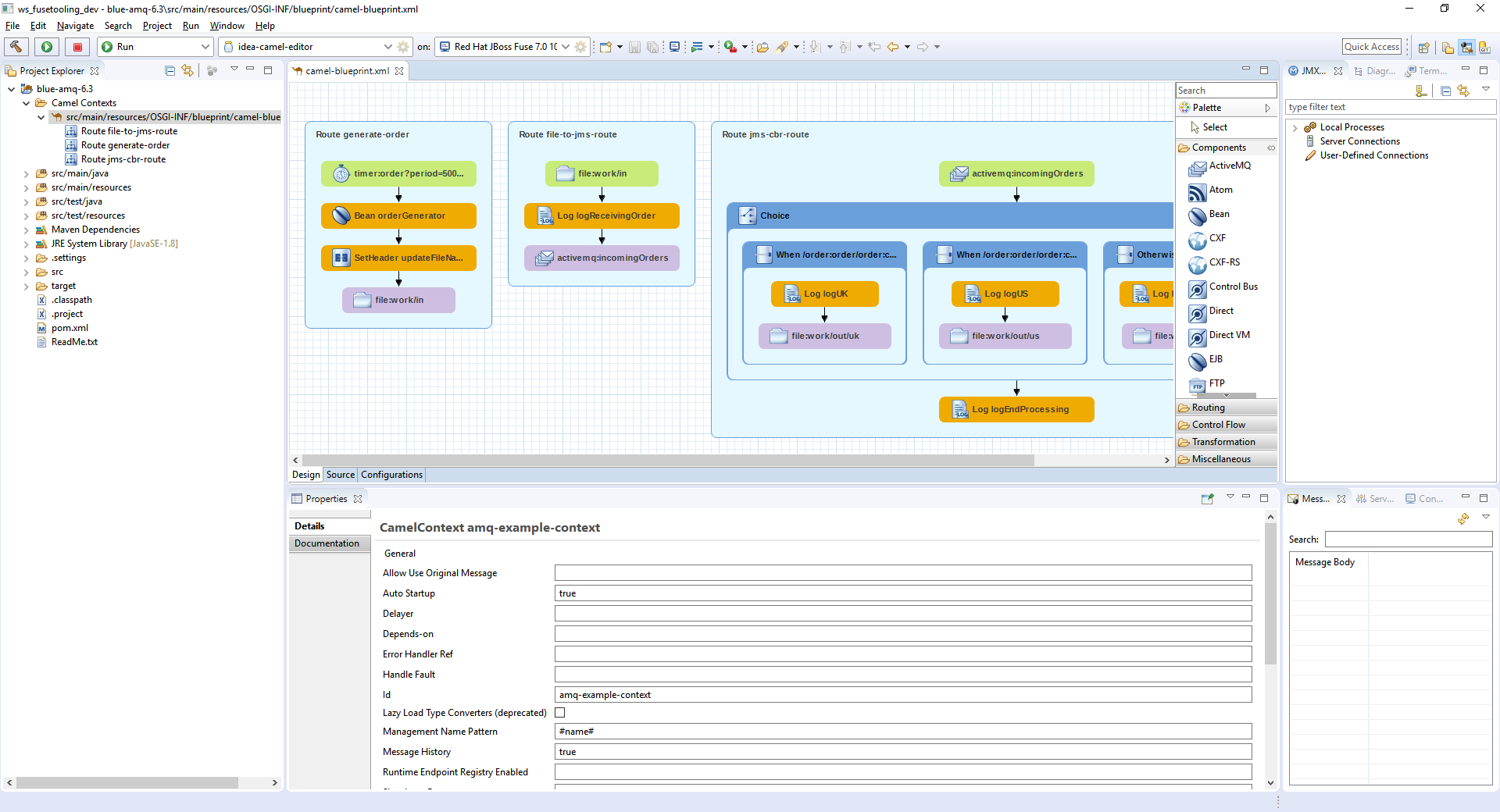
Fuse 7 Karaf-based runtime Server adapter
Fuse 7 is cooking and preliminary versions are already available on early-access repository. Fuse Tooling is ready to leverage them so that you can try the upcoming major Fuse version.
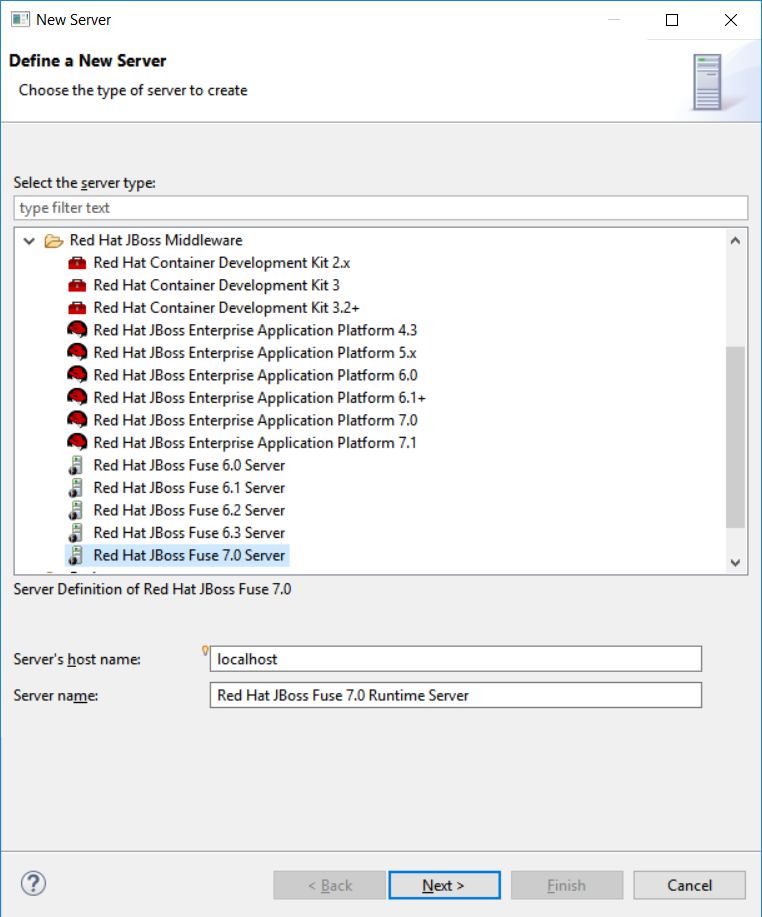
Classical functionalities with server adapters are available: automatic redeploy, Java debug, Graphical Camel debug through created JMX connection. Please note: - you can’t retrieve the Fuse 7 Runtime yet directly from Fuse tooling, it is required to download it on your machine and point to it when creating the Server adapter. - the provided templates requires some modifications to have them working with Fuse 7, mainly adapting the bom. Please see work related to it in this JIRA task and its children.
Display routes defined inside "routeContext" in Camel Graphical Editor (Design tab)
"routeContext" tag is a special tag used in Camel to provide the ability to reuse routes and to split them across different files. This is very useful on large projects. See Camel documentation for more information. Since this version, the Design of the routes defined in "routeContext" tags are now displayed.
Usability improvement: Progress bar when "Changing the Camel version"
Since Fuse Tooling 10.1.0, it is possible to change the Camel version. In case the Camel version was not cached locally yet and for slow internet connections, this operation can take a while. There is now a progress bar to see the progress.
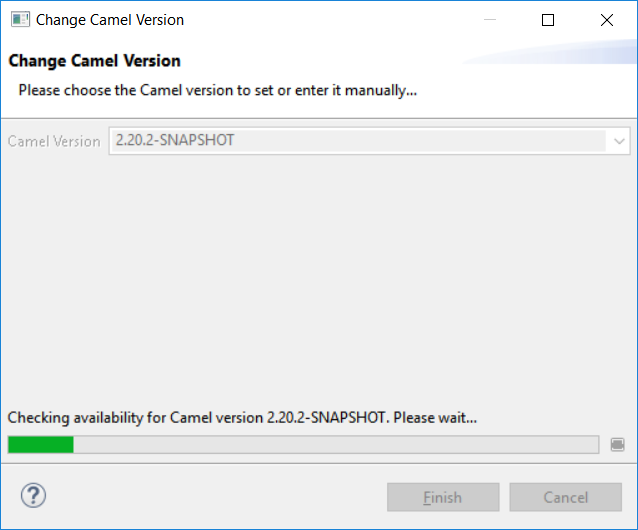
Support for creating Fuse Ignite Technical Extensions
We are happy to announce the addition of support for creating Technical Extension projects for Fuse Ignite*. That includes the creation of the project using the "New Fuse Ignite Extension Project" wizard as well as support for building the deployable artifact directly from inside the Eclipse environment.
*Fuse Ignite is a JBoss Fuse feature that provides a web interface for integrating applications. Without writing code, a business expert can use Ignite to connect to applications and optionally operate on data between connections to different applications. In Ignite, a data operation is referred to as a step in an integration. Ignite provides steps for operations such as filtering and mapping data. To operate on data in ways that are not provided by Ignite built-in steps, you can develop an Ignite extension to define one or more custom steps. Fuse Ignite comes as part of Fuse and Fuse Online. Please refer to the online documentation for more information on how to create and configure technical extensions for Fuse Ignite.
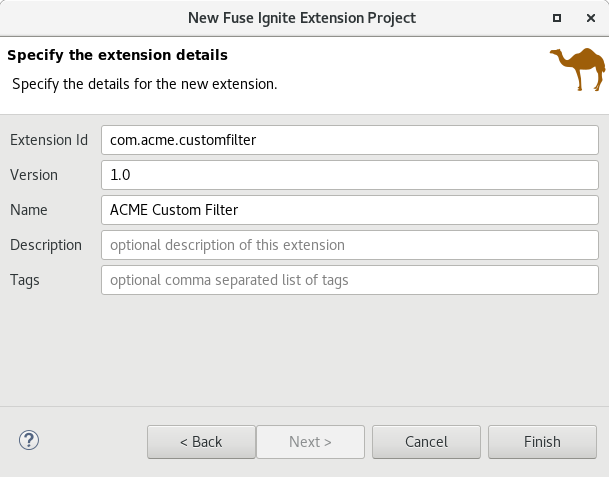
The provided project template allows you to define an Apache Camel route as the base flow of your new technical extension.
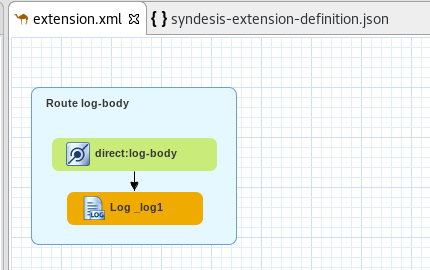
To configure your new technical extension you can use the JSON file created with the new project.

OpenShift
Spring Boot applications support in OpenShift server adapter
The OpenShift server adapter allowed hotdeploy and debugging for JEE and NodeJS based applications. It now supports Spring Boot applications with some limitations: the Spring Boot devtools module must be added to your application as it monitors code changes and as the application must be launched in exploded mode, you must use the upstream image (docker.io/fabric8/s2i-java) rather than the downstream image builder fis-java-openshift.
As an example, we’ve provided an OpenShift template that will create an OpenShift application based on the upstream application and a Git repository that added the Spring Boot devtools to the Fabric8 Spring Boot quickstart.
{
"apiVersion": "v1",
"kind": "Template",
"metadata": {
"annotations": {
"description": "Spring-Boot and CXF JAXRS QuickStart. This example demonstrates how you can use Apache CXF JAXRS with Spring Boot on Openshift. The quickstart uses Spring Boot to configure a little application that includes a CXF JAXRS endpoint with Swagger enabled.",
"tags": "quickstart,java,springboot,fis",
"iconClass": "icon-jboss",
"version": "2.0"
},
"name": "s2i-spring-boot-cxf-jaxrs"
},
"labels": {
"template": "s2i-spring-boot-cxf-jaxrs"
},
"parameters": [
{
"name": "APP_NAME",
"displayName": "Application Name",
"required": true,
"value": "s2i-spring-boot-cxf-jaxrs",
"description": "The name assigned to the application."
},
{
"name": "GIT_REPO",
"displayName": "Git Repository URL",
"required": true,
"value": "https://github.com/jeffmaury/spring-boot-cxf-jaxrs.git",
"description": "The URL of the repository with your application source code."
},
{
"name": "GIT_REF",
"displayName": "Git Reference",
"value": "hotdeploy",
"description": "Set this to a branch name, tag or other ref of your repository if you are not using the default branch."
},
{
"name": "SERVICE_NAME",
"displayName": "Service Name",
"value": "cxf-jaxrs",
"description": "Exposed service name."
},
{
"name": "BUILDER_VERSION",
"displayName": "Builder version",
"value": "2.0",
"description": "The version of the FIS S2I builder image to use."
},
{
"name": "APP_VERSION",
"displayName": "Application Version",
"value": "1.0.0.redhat-000014",
"description": "The application version."
},
{
"name": "MAVEN_ARGS",
"displayName": "Maven Arguments",
"value": "package -DskipTests -Dfabric8.skip -e -B",
"description": "Arguments passed to mvn in the build."
},
{
"name": "MAVEN_ARGS_APPEND",
"displayName": "Extra Maven Arguments",
"description": "Extra arguments passed to mvn, e.g. for multi-module builds."
},
{
"name": "ARTIFACT_DIR",
"displayName": "Maven build directory",
"description": "Directory of the artifact to be built, e.g. for multi-module builds."
},
{
"name": "IMAGE_STREAM_NAMESPACE",
"displayName": "Image Stream Namespace",
"value": "openshift",
"required": true,
"description": "Namespace in which the Fuse ImageStreams are installed. These ImageStreams are normally installed in the openshift namespace. You should only need to modify this if you've installed the ImageStreams in a different namespace/project."
},
{
"name": "BUILD_SECRET",
"displayName": "Git Build Secret",
"generate": "expression",
"description": "The secret needed to trigger a build.",
"from": "[a-zA-Z0-9]{40}"
},
{
"name": "CPU_REQUEST",
"displayName": "CPU request",
"value": "0.2",
"required": true,
"description": "The amount of CPU to requests."
},
{
"name": "CPU_LIMIT",
"displayName": "CPU limit",
"value": "1.0",
"required": true,
"description": "The amount of CPU the container is limited to use."
}
],
"objects": [
{
"apiVersion": "v1",
"kind": "Route",
"metadata": {
"labels": {
"component": "${APP_NAME}",
"provider": "s2i",
"project": "${APP_NAME}",
"version": "${APP_VERSION}",
"group": "quickstarts"
},
"name": "${SERVICE_NAME}-route"
},
"spec": {
"to": {
"kind": "Service",
"name": "${SERVICE_NAME}"
}
}
},
{
"apiVersion": "v1",
"kind": "Service",
"metadata": {
"annotations": {
},
"labels": {
"component": "${APP_NAME}",
"provider": "s2i",
"project": "${APP_NAME}",
"version": "${APP_VERSION}",
"group": "quickstarts"
},
"name": "${SERVICE_NAME}"
},
"spec": {
"clusterIP": "None",
"deprecatedPublicIPs": [],
"ports": [
{
"port": 9413,
"protocol": "TCP",
"targetPort": 8080
}
],
"selector": {
"project": "${APP_NAME}",
"component": "${APP_NAME}",
"provider": "s2i",
"group": "quickstarts"
}
}
},
{
"kind": "ImageStream",
"apiVersion": "v1",
"metadata": {
"name": "${APP_NAME}",
"creationTimestamp": null,
"labels": {
"component": "${APP_NAME}",
"group": "quickstarts",
"project": "${APP_NAME}",
"provider": "s2i",
"version": "${APP_VERSION}"
}
},
"spec": {},
"status": {
"dockerImageRepository": ""
}
},
{
"kind": "BuildConfig",
"apiVersion": "v1",
"metadata": {
"name": "${APP_NAME}",
"creationTimestamp": null,
"labels": {
"component": "${APP_NAME}",
"group": "quickstarts",
"project": "${APP_NAME}",
"provider": "s2i",
"version": "${APP_VERSION}"
}
},
"spec": {
"triggers": [
{
"type": "GitHub",
"github": {
"secret": "${BUILD_SECRET}"
}
},
{
"type": "Generic",
"generic": {
"secret": "${BUILD_SECRET}"
}
},
{
"type": "ConfigChange"
},
{
"type": "ImageChange",
"imageChange": {}
}
],
"source": {
"type": "Git",
"git": {
"uri": "${GIT_REPO}",
"ref": "${GIT_REF}"
}
},
"strategy": {
"type": "Source",
"sourceStrategy": {
"from": {
"kind": "DockerImage",
"name": "fabric8/s2i-java:${BUILDER_VERSION}"
},
"forcePull": true,
"incremental": true,
"env": [
{
"name": "BUILD_LOGLEVEL",
"value": "5"
},
{
"name": "ARTIFACT_DIR",
"value": "${ARTIFACT_DIR}"
},
{
"name": "MAVEN_ARGS",
"value": "${MAVEN_ARGS}"
},
{
"name": "MAVEN_ARGS_APPEND",
"value": "${MAVEN_ARGS_APPEND}"
}
]
}
},
"output": {
"to": {
"kind": "ImageStreamTag",
"name": "${APP_NAME}:latest"
}
},
"resources": {}
},
"status": {
"lastVersion": 0
}
},
{
"kind": "DeploymentConfig",
"apiVersion": "v1",
"metadata": {
"name": "${APP_NAME}",
"creationTimestamp": null,
"labels": {
"component": "${APP_NAME}",
"group": "quickstarts",
"project": "${APP_NAME}",
"provider": "s2i",
"version": "${APP_VERSION}"
}
},
"spec": {
"strategy": {
"resources": {}
},
"triggers": [
{
"type": "ConfigChange"
},
{
"type": "ImageChange",
"imageChangeParams": {
"automatic": true,
"containerNames": [
"${APP_NAME}"
],
"from": {
"kind": "ImageStreamTag",
"name": "${APP_NAME}:latest"
}
}
}
],
"replicas": 1,
"selector": {
"component": "${APP_NAME}",
"deploymentconfig": "${APP_NAME}",
"group": "quickstarts",
"project": "${APP_NAME}",
"provider": "s2i",
"version": "${APP_VERSION}"
},
"template": {
"metadata": {
"creationTimestamp": null,
"labels": {
"component": "${APP_NAME}",
"deploymentconfig": "${APP_NAME}",
"group": "quickstarts",
"project": "${APP_NAME}",
"provider": "s2i",
"version": "${APP_VERSION}"
}
},
"spec": {
"containers": [
{
"name": "${APP_NAME}",
"image": "library/${APP_NAME}:latest",
"readinessProbe" : {
"httpGet" : {
"path" : "/health",
"port" : 8081
},
"initialDelaySeconds" : 10
},
"livenessProbe" : {
"httpGet" : {
"path" : "/health",
"port" : 8081
},
"initialDelaySeconds" : 180
},
"ports": [
{
"containerPort": 8778,
"name": "jolokia"
}
],
"env" : [ {
"name" : "KUBERNETES_NAMESPACE",
"valueFrom" : {
"fieldRef" : {
"fieldPath" : "metadata.namespace"
}
}
} ],
"resources": {
"requests": {
"cpu": "${CPU_REQUEST}"
},
"limits": {
"cpu": "${CPU_LIMIT}"
}
}
}
]
}
}
},
"status": {}
}
]
}You can see a demo of the OpenShift server adapter for Spring Boot application here:
Related JIRA: JBIDE-25303
Enhanced command to delete resource(s)
When it comes to delete OpenShift resources, you had two different choices:
-
individually delete each resource but as some resources are hidden by the OpenShift explorer, it may become troublesome
-
delete the containing OpenShift project but you are then deleting more resources than required
There is now a new enhanced command to delete resources. It is available at the OpenShift project level and it will first list all the available OpenShift resources for the selected OpenShift project. You can now select the ones you want to delete and you can also filter the list using a filter that will be applied to the labels for each retrieved OpenShift resource.
So if you have two different deployments in a single OpenShift project (if you using OpenShift Online Starter for example) or if you have different kind of resources in a single deployment, you can now distinct them.
Let’s see this in action:
In this example, I have deployed an EAP6.4 based application and an EAP7.0 based one. Here is what you can see from the OpenShift explorer:

Now, let’s invoke the new delete command on the eap OpenShift project: right click the OpenShift project and select Delete Resources…:
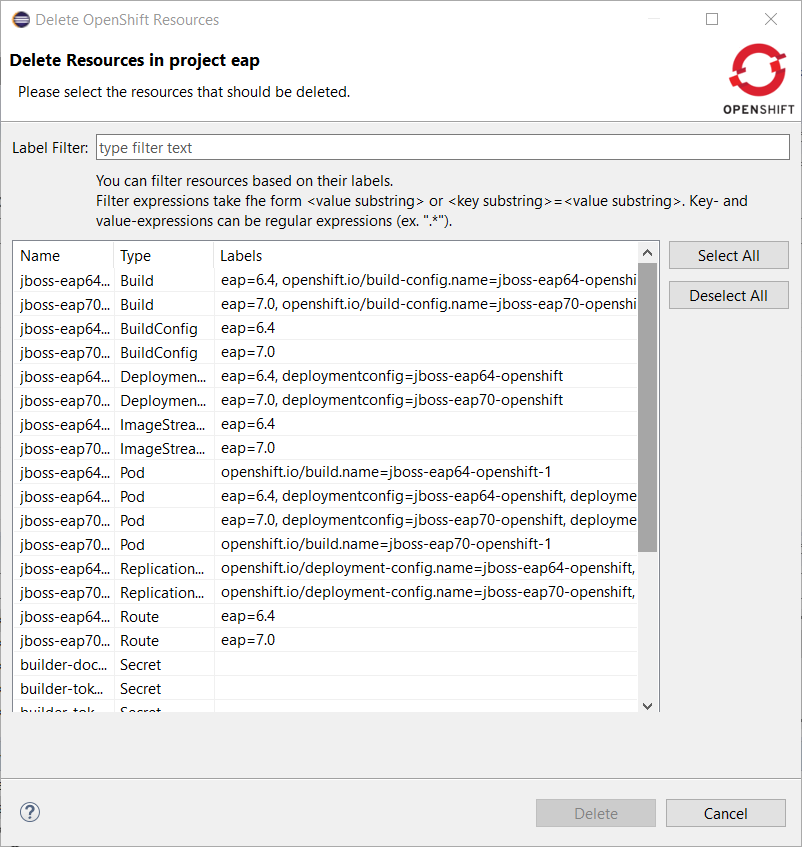
Let suppose that we want to delete the EAP6.4 deployement. Enter eap=6.4 in the filter field:
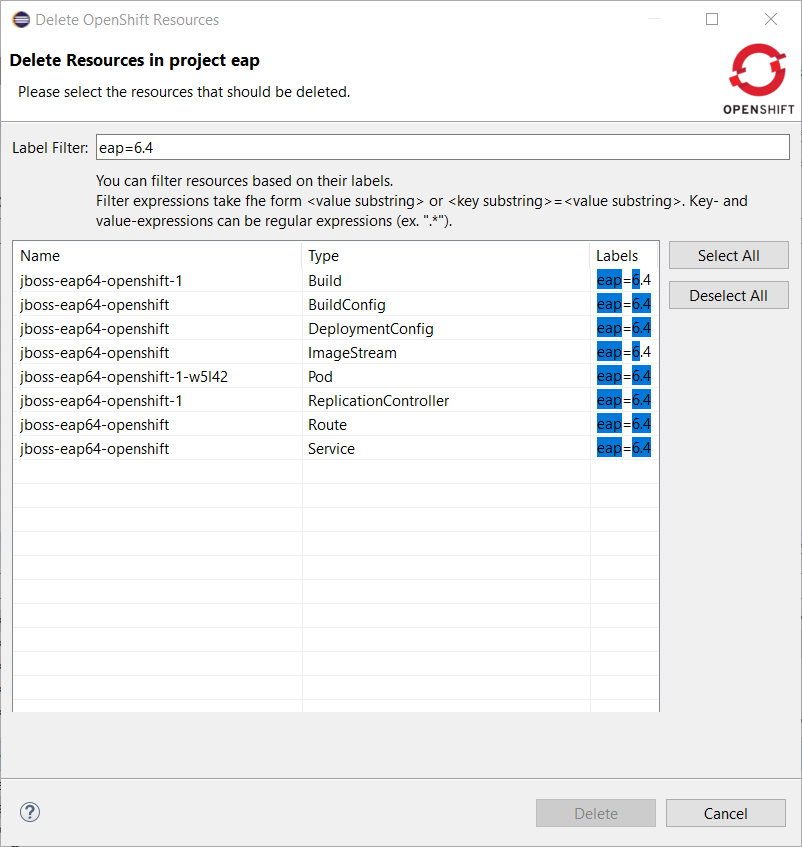
Push the Select All button:
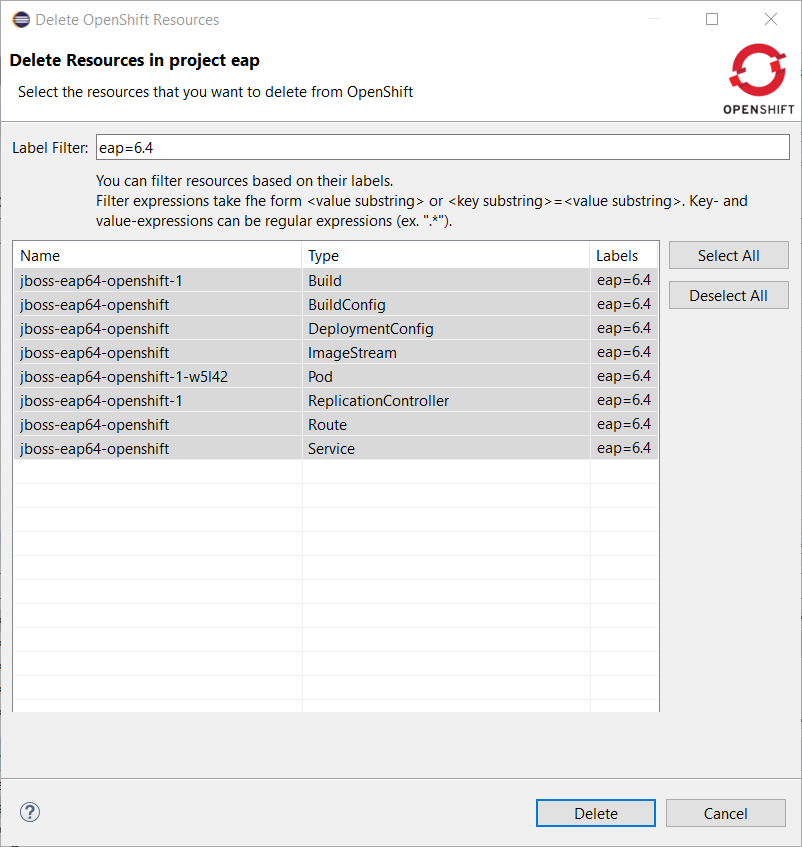
Close this dialog by pushing the OK button. The resources will be deleted and the OpenShift explorer will be updated accordingly:

Related JIRA: JBIDE-25111
Support for route timeouts and liveness probe for OpenShift Server Adapter debugging configurations
While debugging your OpenShift deployment, you may face two different issues:
-
if you launch your test through a Web browser, then it’s likely that you will access your OpenShift deployment through an OpenShift route. The problem is that, by default, OpenShift routes have a 30 seconds timeout for each request. So if you’re stepping through one of your breakpoints, you will get a timeout error message in the browser window even if you can still debug your OpenShift deployment. And you’re now stuck will the navigation of your OpenShift application.
-
if your OpenShift deployment has a liveness probe configured, depending on your virtual machine capabilities or how your debugger is configured, if your stepping into one of your breakpoints, the liveness probe may fail thus OpenShift so OpenShift will restart your container and your debugging session will be destroyed.
So, from now, when the OpenShift server adapter is started in debug mode, the following action are being performed:
-
if an OpenShift route is found that is linked to the OpenShift deployment you want to debug, the route timeout will be set or increased to 1 hour. The original or default value will be restored when the OpenShift server adapter will be restarted in
runmode. -
if your OpenShift deployment has a liveness probe configured, the
initialDelayfield will be increased to 1 hour if the defined value for this field is lower than 1 hour. If the value of this field is defined to a value greater than 1 hour, it is left intact. The original value will be restored when the OpenShift server adapter will be restarted inrunmode
Related JIRA: JBIDE-24868